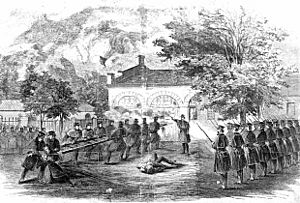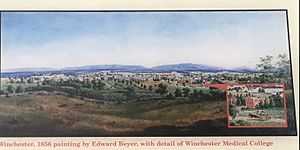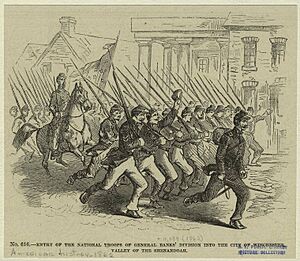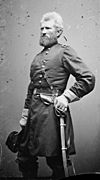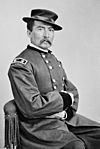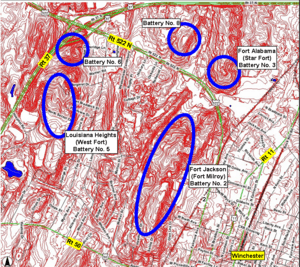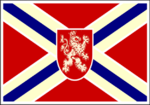Winchester, Virginia, in the American Civil War facts for kids
The city of Winchester, Virginia, and the area around it, saw many battles during the American Civil War. Armies fought hard to control the lower Shenandoah Valley. Winchester changed hands more often than any other city in the Confederate States.
Contents
Why was Winchester Important?
The Start of the Conflict
The connection between Winchester and the American Civil War began in October 1859. This was when John Brown's raid happened in nearby Harpers Ferry. Colonel Lewis Tilghman Moore led 150 local soldiers from Frederick County. They traveled by train to Harpers Ferry, about 30 miles away.
Sadly, the first person to die in Brown's raid was Heyward Shepherd. He was a free Black man from Winchester who worked for the B&O Railroad. He was buried in Winchester with military honors. After the raid, Judge Richard Parker from Winchester was the judge for John Brown's trial. He sentenced Brown to death.
John Brown was seen as a hero by the Union and a villain by the Confederacy. He died trying to end slavery. Union soldiers even marched to a song called John Brown's Body, which later became the Battle Hymn of the Republic.
Later, on May 16, 1862, Union officers burned down the Winchester Medical College. They didn't let firefighters put out the fire, and the building was completely destroyed. The college never opened again.
Deciding to Join the Confederacy
Neither Winchester nor Virginia were very eager to leave the Union. Virginia wasn't a "cotton state." Its economy was mostly about small family farms growing wheat and raising cattle. However, many people who supported the Union had conditions.
For example, in December 1860, Robert Young Conrad, a Union supporter, helped create a statement in Winchester. It said that Northerners were fighting an "insane war" against Southern ways. It also said that slavery was "consistent with civilization." Virginians would not "submit" to limits on their rights. They asked the North to change laws about runaway slaves and stop abolitionists.
But at the same time, they said they were against leaving the Union. They promised to stay loyal to the Union. They even suggested boycotting goods from some Northern states. They also called for a national meeting to solve the problems.
In January 1861, Virginia's Governor John Letcher called for a Peace Conference of 1861. This meeting failed to get the U.S. Congress to agree on a compromise. On February 4, 1861, Virginia held an election for delegates to a special meeting about secession. Winchester and Frederick County chose two delegates who were against leaving the Union:
- Robert Y. Conrad
- James Marshall
Two-thirds of the votes went to these two Union-friendly candidates. This showed that the town and county strongly supported the Union then. On April 4, the convention voted, and secession was defeated 88 to 45.
However, later that month, the attack on Fort Sumter happened. President Abraham Lincoln then asked for 75,000 volunteers, including troops from Virginia. Governor Letcher refused Lincoln's request on April 15. Because of this, the convention passed an order to secede on April 17, by a vote of 88 to 55. This was approved by a public vote on May 23, 1861. Right after this vote, Governor Letcher ordered the capture of the federal arsenal at Harpers Ferry. Soldiers from Winchester were among the first to arrive, led by Colonel Thomas J. "Stonewall" Jackson.
Winchester's Key Location
Winchester was located at the northern end of the lower Shenandoah Valley. It was north of Washington, D.C., the capital city of the Union. Winchester was a central point for major roads connecting the Ohio Valley to the eastern United States. It was just south of the Potomac River. Winchester was on the only route between the east and west that had direct connections to Washington, D.C.
Many important transportation routes passed through or near Winchester:
- The Baltimore and Ohio Railroad
- The Chesapeake and Ohio Canal
- The Winchester and Potomac Railroad
- The Valley Pike and Martinsburg Pike
- The Millwood Pike
Winchester was a base for several Confederate attacks into the Northern United States. These attacks sometimes threatened Washington, D.C. Winchester also served as a central point for troops raiding the Baltimore and Ohio Railroad, Chesapeake and Ohio Canal, and telegraph lines. For example, in 1861, Col. Thomas J. Jackson removed 56 locomotives and 386 railroad cars, along with miles of track, from the B&O Railroad. This shut down the B&O's main line for ten months. Much of the effort to move this equipment by horse and wagon was based in Winchester.
Major Battles Near Winchester
Winchester was a very important place for the Confederate States Army during the war. It was a key goal in many campaigns, including:
- Gen. Joseph E. Johnston's and Jackson's defense of the Shenandoah Valley in 1861.
- Stonewall Jackson's Valley Campaign of 1862.
- The Gettysburg Campaign of 1863.
- The Valley Campaigns of 1864.
Here are some of the main battles fought around Winchester:
- 1861
- The Great Train Raid of 1861, May 23 – June 23, 1861
- The Skirmish of Falling Waters, July 2, 1861
- 1862
- The Romney Expedition, January 1–24, 1862
- The First Battle of Kernstown, March 23, 1862
- The First Battle of Winchester, May 25, 1862
- The Battle of Harpers Ferry, September 12–15, 1862
- 1863
- The Second Battle of Winchester, June 13–15, 1863
- 1864
- The Battle of Snicker's Ferry, July 17–18, 1864
- The Battle of Rutherford's Farm, July 20, 1864
- The Second Battle of Kernstown, July 24, 1864
- The Battle of Berryville, September 3–4, 1864
- The Third Battle of Winchester, September 19, 1864
- The Battle of Belle Grove (or Cedar Creek), October 19, 1864
Winchester Under Occupation
Winchester changed hands many times during the war. Some say it changed hands as many as 72 times! Battles happened all along Main Street. Both Union General Sheridan and Stonewall Jackson had their headquarters just one block apart at different times.
Winchester suffered a lot under five main periods when the Union army controlled it:
- Major General Nathaniel Banks – (March 12 to May 25, 1862, and June 4 to September 2, 1862)
- Major General Robert Milroy – (December 24, 1862, to June 15, 1863)
- Major General Philip Sheridan – (September 19, 1864, to February 27, 1865)
- Major General Winfield Scott Hancock – February 27, 1865, to June 27, 1865
- Major General John Schofield – (End of War to January 26, 1870)
During these times, many residents were forced to leave town. Personal belongings were stolen. People who helped wounded soldiers were sometimes punished. Homes were taken over and destroyed. The medical school was burned down. Citizens were not allowed to vote on rejoining the Union under Major General Schofield.
General Banks' Occupations (1862)
General Banks' main goal in the Shenandoah Valley in 1861-1862 was to protect Washington, D.C. He also had to defend the Baltimore and Ohio Railroad. In early March 1862, Banks marched his troops into the Shenandoah Valley. He had more soldiers than Major General Stonewall Jackson. General Jackson then left Winchester, moving further up the Valley.
During the summer of 1862, two major battles were fought in Winchester between Banks and Jackson:
- The First Battle of Kernstown, March 23, 1862
- The First Battle of Winchester, May 25, 1862
After the First Battle of Winchester, Banks retreated. Soon after, by May 31, General Jackson left Winchester. Banks then re-entered the town and occupied it from June 4 to September 2, 1862.
General Milroy's Occupation (1862–63)
Winchester was controlled by the Union's 2nd Division from December 24, 1862, until the Second Battle of Winchester on June 15, 1863. The main goal for the Union during this time was to protect routes to Washington, D.C., and especially the Baltimore and Ohio Railroad. Major General Robert Milroy, the division commander, arrived in early 1863. This was around the time the Emancipation Proclamation was put into effect.
Milroy was a strong supporter of ending slavery. He wanted to use Winchester to enforce the new proclamation very strictly. Milroy was known for saying:
In this city (Winchester) of about 6,000 inhabitants ... my will is absolute law – none dare contradict or dispute my slightest word or wish. The secesh here have heard many terrible stories about me before I came and supposed me to be a perfect Nero for cruelty and blood, and many of them both male and female tremble when they come into my presence to ask for small privileges, but the favors I grant them are slight and few for I confess I feel a strong disposition to play the tyrant among these traitors.
Milroy was also known for treating women harshly. If he felt a lady had "insulted Gen Closeret," her "fine mansion was immediately taken for a hospital." In one case, on April 4, General Milroy arrested Mrs. Logan. He accused her of having illegal goods. He had her and her daughters escorted out of town, without even time to get medicine for one sick daughter. He then moved his own wife, Mrs. Milroy, into the Logan family's beautiful home. Ladies in Winchester started walking in the middle of the streets to avoid accidentally touching Union soldiers.
Milroy was also feared for wanting to execute Virginians. He set up his own courts and sentenced townspeople to execution by firing squad, even without proper legal authority.
Many local Black people who were freed in January 1863 under the Emancipation Proclamation left the area. They likely feared that the Confederates would take control again, which did happen later that year.
General Sheridan's "Burning" and Occupation (1864)
Major General Philip Sheridan marched through the Valley from Winchester. He destroyed many farms and supplies. According to official records, he destroyed "2,000 barns filled with grain and implements, not to mention other outbuildings, 70 mills filled with wheat and flour" and "numerous head of livestock." At the end of 1864, General Sheridan famously said that "The crow that flies over the Valley of Virginia must henceforth carry his rations with him". This meant he had destroyed so much that even a crow couldn't find food.
People and Events
Local Confederate Units
Winchester and Frederick County provided many soldiers to the Confederate Army. These units were part of what was called the Army of Northern Virginia.
Here are some of the types of units from the area:
- Infantry (foot soldiers)
- Cavalry (soldiers on horseback)
- Artillery (soldiers who used cannons)
- Militia (local citizen soldiers)
Medical Contributions
Even with the difficulties of war, some Winchester residents made important contributions to medicine. Dr. Hunter McGuire was the chief surgeon for a major part of the Army of Northern Virginia. He helped create rules for how medical doctors should be treated during war. These ideas later influenced the Geneva conventions.
Winchester became a big center for Confederate medical operations, especially after the Battle of Sharpsburg in 1862 and the Battle of Gettysburg in 1863. This helped advance medical practices during wartime.
Winchester Medical College, where Hunter McGuire was a professor, was burned down by Union troops in 1862. It never reopened.
The "Devil Diarists"
Many people in Winchester kept diaries during the war. The Union Secretary of War Edwin Stanton once said about Winchester that "the men are all in the army" and "the women are the devil." General Milroy also said, "Hell is not full enough... There must be more of these Secession women of Winchester to fill it up."
Here are some people who kept famous diaries:
- Portia Baldwin Baker – She wrote about Union soldiers destroying buildings.
- Julia Chase – She was from Maine but lived in Winchester. She supported the Union. She saw how Confederates treated Union supporters badly. She celebrated when Sheridan's army won the Third Battle of Winchester in 1864.
- Laura Lee – She supported the Confederacy.
- Mary Greenhow Lee – She was from a wealthy family and supported the Confederacy. General Sheridan forced her to leave Winchester in February 1865, and she never returned.
- Cornelia Peake McDonald – Her home was used as a hospital.
- Kate Sperry – She supported the Confederacy and famously said, "Surrender? Never Surrender."
Future Presidents in Battle
Two future U.S. presidents fought in battles at Winchester: William McKinley and Rutherford B. Hayes. Both were officers in the Union Army.
Forts and Camps in Winchester
Main Forts
Winchester was heavily protected by forts and earthworks all around the town. General Milroy built or improved ten defensive forts, called Battery No. 1 through Battery No. 10. These forts were connected by roads and trenches.
- Fort Collier: This fort protected the north entrance of town. It was built by Confederates and later used by the Union.
- Fort Jackson: This was a main fort, improved by both sides. It held many cannons.
- Fort Alabama: This was a large, star-shaped fort built by Union troops. It had 8 cannons.
- Louisiana Heights: This fort was west of Fort Jackson. It was named after the Confederate Louisiana troops who attacked it.
- Carysbrooke Redoubt: This fort was on high ground and part of a two-mile line of earthworks south of Winchester.
Fortified Batteries
These were smaller fortified positions with cannons and trenches.
- Bower's Hill: A long trench line south of Fort Jackson.
- Battery No. 1: A fort with 6 cannons on the same ridge as Fort Jackson.
- Battery No. 4: A large, star-shaped fort with 6 cannons and trenches.
- Battery No. 6: A small fort with 3 cannons.
- Battery No. 7: A large fort with 8 cannons.
- Battery No. 8: A group of forts and trenches west of Fort Alabama.
Camps and Hospitals
- Camp Hill: A camp used by both Confederate and Union armies.
- Smithfield Trench Line: A mile-long Confederate trench line northwest of Winchester.
- Camp Russell: A two-mile-long Union camp with earthworks south of Winchester.
- Camp Sheridan: A Union camp southwest of Winchester.
- Sheridan Field Hospital: The largest Union field hospital in the Civil War, located in Winchester.
- White Sulphur Resort: A hotel used as a hospital by both sides. The buildings are still there today.
Prisons and Headquarters
- Old Court House: Used as a temporary prison and hospital by both sides.
- Stonewall Jackson's Headquarters: This house is now a museum. It was Jackson's winter headquarters in 1861 and 1862.
- General Philip H. Sheridan's Headquarters: Sheridan used the Logan family home as his headquarters in 1864. He started his famous ride from here to rally his troops at Cedar Creek.
Visiting Civil War Sites Today
Today, Winchester offers many places to explore for those interested in the Civil War. Jubal Early Drive goes around the south side of downtown Winchester, where many battles took place.
Some Civil War sites you can visit:
- Cedar Creek and Belle Grove National Historical Park
- Museum of the Shenandoah Valley
- Old Court House Civil War Museum
- Stonewall Cemetery
- Stonewall Jackson's Headquarters Museum
- Winchester Confederate Cemetery
- Winchester National Cemetery
- Kernstown Battlefield
Interesting Facts
The Flag of Winchester
The modern flag of Winchester looks a lot like a flag that was once suggested for the Confederate States of America. Both flags have a red background with a saltire (a diagonal cross, like the Saint Andrew's Cross) on it. They also have a shield in the center. The main differences are that the Winchester flag has a blue saltire in the middle and an English "Norman" lion instead of a 13-pointed star on the shield. The Confederate congress did not choose this flag in 1862.


